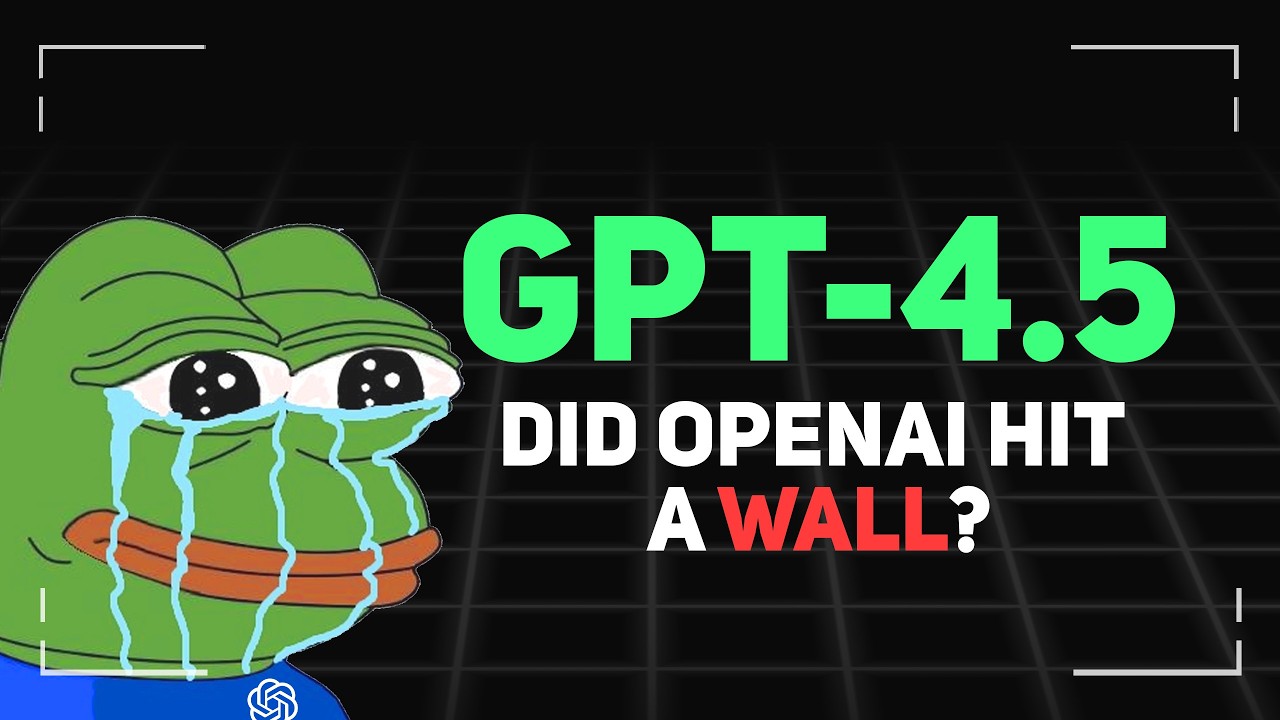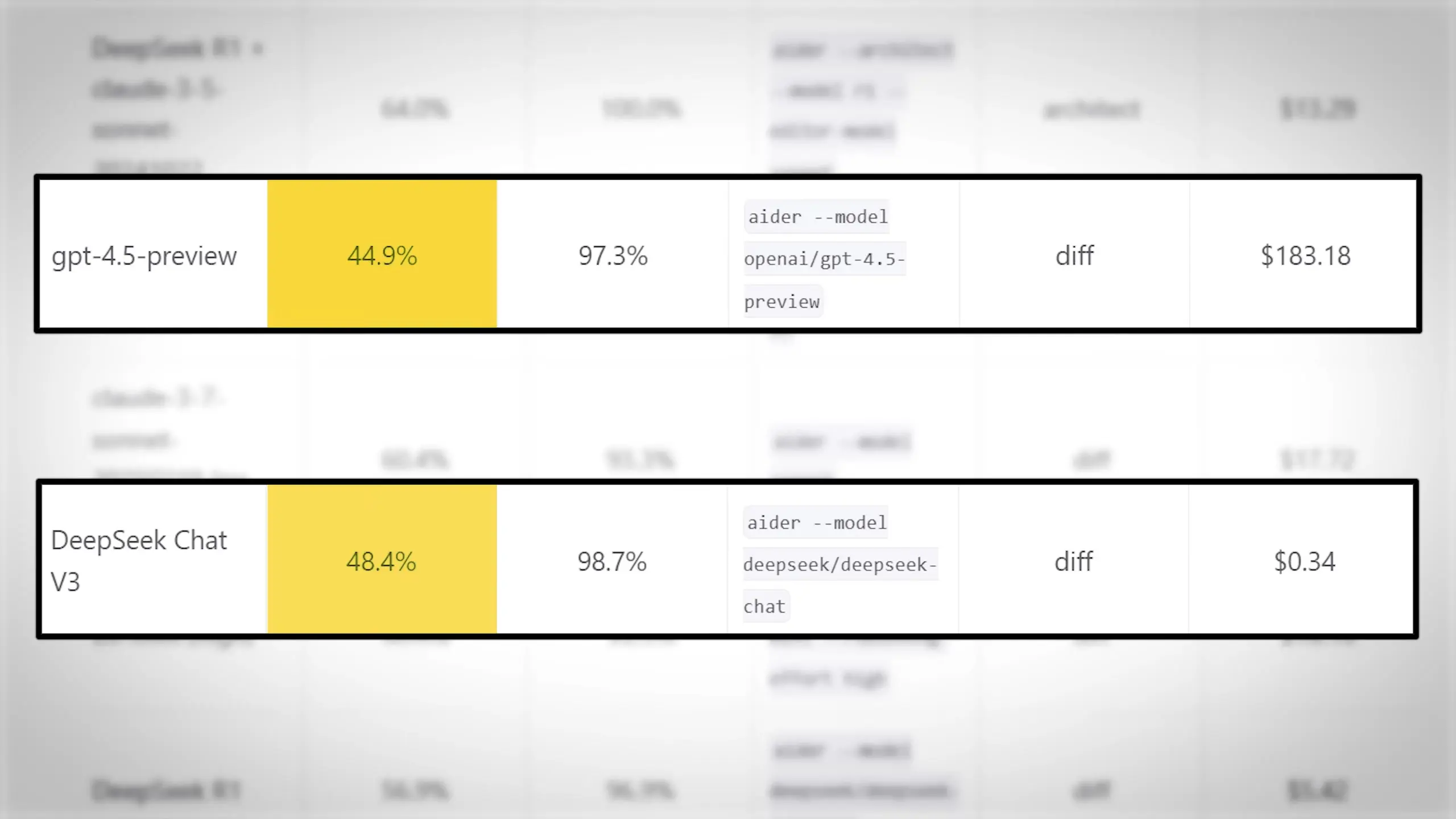
The recent release of GPT-4.5 has left many AI enthusiasts and professionals feeling underwhelmed, with benchmark results revealing surprising limitations in OpenAI's latest flagship model. Despite months of anticipation and hype, GPT-4.5's performance metrics suggest it may not represent the revolutionary advancement many expected, especially when compared to open-source alternatives that have emerged in recent months.
GPT-4.5 vs. DeepSeek V3: An Unexpected Comparison
One of the most shocking revelations from recent benchmark tests is how GPT-4.5 compares to DeepSeek V3, an open-source model released just two months ago. When examining performance across key metrics, GPT-4.5 underperforms against DeepSeek V3 in several critical areas:
- Math benchmarks: DeepSeek V3 outperforms GPT-4.5 on the challenging AM24 mathematical reasoning tests
- Coding capabilities: DeepSeek V3 demonstrates superior performance on programming-related tasks
- Cost efficiency: DeepSeek V3 costs approximately 500 times less to run than GPT-4.5 for similar or better performance
- Overall efficiency: DeepSeek V3 achieved its benchmark scores at a fraction of the computational cost

These results raise important questions about OpenAI's approach to model development and the value proposition of their latest offering. While GPT-4.5 does outperform DeepSeek V3 in science and multilingual benchmarks, the overall performance differential doesn't appear to justify the massive price disparity between the models.
Understanding GPT-4.5's Key Limitations
According to the benchmark data and initial assessments, GPT-4.5 exhibits several notable limitations that potential users should consider:
- Mathematical reasoning deficiencies compared to competitors and expectations
- Prohibitive API pricing (12 times more expensive than GPT-4o for only 2-4 times improvement)
- Limited innovation beyond reducing hallucinations and improving conversational naturalness
- Underwhelming performance on third-party benchmarks like ADER (scoring only 45%)
- Significant resource requirements that may indicate inefficient model architecture
OpenAI representatives mentioned during the announcement that GPT-4.5 is a "huge model" and hinted at challenges in making it work effectively. This suggests potential architectural inefficiencies that contrast sharply with the innovations coming from competitors like DeepSeek, who have published research papers on more efficient training and inference methods.
The Cost Factor: GPT-4.5's Pricing Problem
Perhaps the most striking limitation of GPT-4.5 is its pricing structure. The API costs reveal a massive disparity between OpenAI's offering and comparable alternatives:
- GPT-4.5 costs approximately 500 times more than DeepSeek V3 for similar performance
- When running benchmark tests, GPT-4.5 cost $183.12 compared to DeepSeek V3's $34
- GPT-4.5 is 12 times more expensive than GPT-4o while delivering only 2-4 times performance improvement
- Access to GPT-4.5 requires a $200 subscription for early access

Innovation Stagnation: Has OpenAI Hit a Wall?
The underwhelming performance of GPT-4.5 raises questions about OpenAI's innovation trajectory. While the company was once at the forefront of AI advancement, recent developments suggest potential challenges:
- Limited novel research publications compared to competitors like DeepSeek
- Reliance on scaling existing approaches rather than fundamental innovation
- Focus on incremental improvements ("feels more natural", "hallucinates less") rather than breakthrough capabilities
- Comparison metrics primarily against their own GPT-4o rather than industry-leading alternatives
- Challenges in efficiently implementing larger models despite substantial resources
This apparent innovation gap is particularly notable given OpenAI's substantial funding and talent pool. The company that once pioneered groundbreaking AI capabilities now appears to be struggling to maintain its technological edge against more agile competitors.
The Competitive Landscape: Open Source Momentum
While GPT-4.5 disappoints, the open source AI community continues to gain momentum. DeepSeek's approach highlights a different development philosophy that's yielding impressive results:
- Publication of innovative research papers on efficient training and inference
- Rapid iteration cycles that deliver significant improvements (V2 to V3 in months)
- Cost-effective models that perform at or above commercial alternatives
- Focus on mathematical and coding capabilities that address real-world use cases
- Open development approach that enables community contributions and improvements

Interestingly, DeepSeek recently announced an "open source week" with 50% discounts across their APIs - a move that stands in stark contrast to OpenAI's premium pricing approach and closed development model.
Practical Implications for AI Practitioners
For developers, researchers, and organizations looking to implement AI solutions, GPT-4.5's limitations present important considerations:
- Cost-benefit analysis strongly favors alternatives like DeepSeek V3 for many use cases, especially those involving mathematical reasoning or coding
- Organizations with budget constraints may find open-source models provide better value while meeting performance requirements
- Applications requiring multilingual capabilities or scientific reasoning may still benefit from GPT-4.5's strengths
- The rapid advancement of open-source models suggests waiting for commercial adoption may be unnecessary for many applications
- Hybrid approaches using multiple models for different tasks may deliver optimal results at lower costs
As the AI landscape continues to evolve, practitioners should carefully evaluate model performance across specific domains relevant to their use cases rather than assuming the latest commercial release represents the state of the art.
Conclusion: Reassessing Expectations in the AI Race
GPT-4.5's release marks an important moment in AI development - not for its breakthrough capabilities, but for what it reveals about the changing dynamics in the field. The limitations demonstrated by OpenAI's latest model, particularly when compared to open-source alternatives, suggest we may be entering a new phase where innovation is more distributed and commercial advantages less pronounced.
For users and organizations implementing AI solutions, this changing landscape offers both challenges and opportunities. While navigating an increasingly complex ecosystem of models requires more careful evaluation, the availability of high-performing, cost-effective alternatives provides more options than ever before. As GPT-4.5 demonstrates, the biggest name in AI doesn't always deliver the best performance or value - a reality that promises to make the AI space more competitive and innovative in the long run.
Let's Watch!
GPT-4.5 Disappoints: Benchmarks Show Surprising Limitations Against Open Source Models
Ready to enhance your neural network?
Access our quantum knowledge cores and upgrade your programming abilities.
Initialize Training Sequence